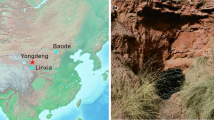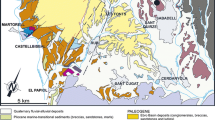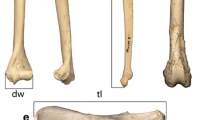Abstract
A well-preserved felid skull from the Turolian (late Miocene) of Karaslari (FY Republic of Macedonia) is described and assigned to a new taxon, Yoshi garevskii, gen. et sp. nov. The new genus Yoshi is characterized by a round, short, and deep skull, and short canines that are somewhat transversely compressed but are not serrated. We assign to the same genus the poorly preserved skulls from the Aegean region described as Metailurus parvulus (Hensel, 1862), the Chinese type of “Metailurus” minor Zdansky, 1924, as well as some other skulls from China. The latter name thus becomes Y. minor (Zdansky, 1924), but the former name is a nomen dubium. The genus Metailurus Zdansky, 1924, is represented by the type-species M. major Zdansky, 1924; it considerably differs from the forms here referred to the new genus, and is closer to the Machairodontinae. Although definitely more plesiomorphic in dental features, Yoshi, especially Y. garevskii, reaches a high specialization in its skull shape, parallel to that of the cheetah, suggesting that it represents the first attempt towards the morpho-functional model of this modern felid.









Similar content being viewed by others
References
Andersson K (1998) Redescription of the Uppsala material of Metailurus, with a review of the genus. Master of Science Thesis, Uppsala University, 30 p
Andersson K, Werdelin L (2005). Carnivora from the late Miocene of Lantian, China. Vertebr PalAsia 43: 256–271
Boev Z, Spassov N (2009) First record of ostriches (Aves, Struthioniformes, Struthionidae) from the late Miocene of Bulgaria with taxonomic and zoogeographic discussion. Geodiversitas 31(3): 493–507
Chang H (1958). On the skull of Metailurus of Pontian age from Shansi. Vertebr PalAsia 2(1): 47–49
Christiansen P (2013) Phylogeny of the sabertoothed felids (Carnivora: Felidae: Machairodontinae). Cladistics 29: 543–559
Clavel J, Merceron G, Hristova L, Spassov N, Kovachev D, Escarguel G (2012) On Mesopithecus habitat: insights from late Miocene fossil vertebrate localities of Bulgaria. J Hum Evol 63(1): 162–79
Colbert E (1939) Carnivora of the Tung Gur Formation of Mongolia. Bull Am Mus Nat Hist 76 : 47–81
Crusafont M, Aguirre E (1972) Stenailurus, Félidé nouveau du Turolien d’Éspagne. Ann Paléontol 58(2): 211–223
Beaumont G de (1961) Recherches sur Felis attica Wagner du Pontien eurasiatique avec quelques observations sur les genres Pseudaelurus Gervais et Proailurus Filhol. Nouvelles Archives du Muséum d’Histoire Naturelle de Lyon 6: 1–45
Bonis L, Peigné S, Taisso Mackaye H, Likius L, Vignaud P, Brunet M (2008) The fossil vertebrate locality Kossom Bougoudi, Djurab desert, Chad: a window in the distribution of the carnivoran faunas at the Mio–Pliocene boundary in Africa. C R Palevol 7: 571–581
Eronen J, Ataabadi M, Micheels A, Karme A, Bernor R, Fortelius M (2009) Distribution history and climatic controls of the late Miocene Pikermian chronofauna. Proc Natl Acad Sci USA 106(29):11867–71
Ewer R (1973) The Carnivores. Cornell University Press, Ithaca and London
Forstén A, Garevski R (1989) Hipparions (Mammalia, Perissodactyla) from Macedonia (Yugoslavia). Geol macedonica 1–2: 159–206
Garevski R (1956) Neue Fundstellen von Pikermifauna in Mazedonien. Acta musei macedonici scientiarum naturalium Skopje 4(35): 67–96
Garevski R, Zapfe H (1983) Weitere Chalicotheriiden-Funde aus der Pikermi-Fauna von Titov Veles (Mazedonien, Jugoslawien). Acta musei macedonici scientiarum naturalium Skopje 7: 1–20
Garevski R, Markov G (2011) A Deinotherium gigantissimum (Mammalia, Proboscidea) palate with deciduous dentition from the area of Veles, Republic of Macedonia. Paläontol Z 85: 33–36
Geraads D (2009) Giraffidae (Mammalia) de la fin du Néogène de la République de Macédoine (ARYM). Geodiversitas 31(4): 893–908
Geraads D (2014) How old is the cheetah skull shape ? The case of Acinonyx pardinensis (Mammalia, Felidae). Geobios
Geraads D, Spassov N, Garevski R (2008) New specimens of Propotamochoerus (Suidae, Mammalia) from the late Miocene of the Balkans. N Jahrb Geol Paläontol Abhandl 248(1): 103–113
Goloboff PA, Farris JS, Nixon KC (2008) TNT, a free program for phylogenetic analysis. Cladistics 24: 774–786
Hensel RF (1862) Über die Reste einiger Säugetierarten von Pikermi in der Münchener Sammlung. Monatsberichte Akad Wiss 27: 560–569
Hibbard CW (1934) Two new genera of Felidae from the Middle Pliocene of Kansas. Trans Kansas Acad Sci 37: 239–255
Koufos GD (2009) The late Miocene mammal faunas of the Mytilinii Basin, Samos Island, Greece: new collection. 5. Carnivora. Beiträge Paläontol 31: 57–105
Kovachev D (2001) Description d’un squelette complet de Metailurus (Felidae, Carnivora, Mammalia) du Miocène supérieur de Bulgarie. Geol Balcanica 31(3–4): 71–88
Krausman R, Morales S (2005) Acinonyx jubatus. Mammal Species 771: 1–6
Kretzoi M (1929) Materialien zur phylogenetischen Klassifikation der Aeluroideen.10ème Congrès International de Zoologie; Sect. 8, Paléozoologie et zoogéographie, Budapest, 1927, pp1293–1355
Kretzoi M (1938) Die Raubtiere von Gombaszög nebst einer Übersicht der Gesamtfauna. Ann Mus Natl Hungarici 31: 88–157
Lungu A (1978) The Hipparion Fauna of the Middle Sarmatian of Moldova. (Carnivores). Shtiintsa, Kishineu, 133
Merceron G, Zazzo A, Spassov N, Geraads D, Kovachev D (2006) Paleoecology and paleoenvironments from the late Miocene of Bulgaria: evidence from dental microwear and stable isotopes. Palaeogeogr Palaeoclimatol Palaeoecol 241: 637–654
Melentis JK (1967) Studien über fossile Vertebraten Griechenlands. 19. Die Pikermifauna von Halmyropotamos (Euböa—Griechenland). 1. Teil: Odontologie und Kraniologie. Ann Géol des Pays Helléniques 19: 285–411
Moore W (1981) The Mammalian Skull. Cambridge University Press, Cambridge - London - New York - New Rochelle - Melbourne - Sydney
Morales J, Soria D (1979) Nuevos datos los carnívoros del área de Teruel. Sintesis y biostratigrafia. Estud geol 35 : 497–504
Ozansoy F (1965) Étude des gisements continentaux et de mammifères du Cénozoique de Turquie. Mém Soc Géol France (n sér) 44: 1–92
Pons-Moyá J (1987) Fortunictis acerensis nov. sp., nuevo Metailurino (Mammalia, Carnivora) del Mioceno superior de la Península Ibérica. Paleontol Evol 21: 63–68
Roussiakis SJ (2001) Metailurus major Zdansky, (1924) (Carnivora, Mammalia) from the classical locality of Pikermi (Attica, Greece). Ann Paléontol 87(2): 119–132
Roussiakis S, Theodorou G, Iliopoulos G (2006) An almost complete skeleton of Metailurus parvulus (Carnivora, Felidae) from the late Miocene of Kerassia (Northern Euboea, Greece). Geobios 39: 563–584
Salesa M, Antón M, Morales J, Peigné S (2012a) Systematics and phylogeny of the small felines (Carnivora, Felidae) from the late Miocene of Europe: a new species of Felinae from the Vallesian of Batallones (MN 10, Madrid, Spain). J Syst Palaeontol 10(1): 87–102
Salesa M, Antón M, Turner A, Morales J (2005) Aspects of the functional morphology in the cranial and cervical skeleton of the sabre-toothed cat Paramachairodus ogygia (Kaup, 1832) (Felidae,Machairodontinae) from the late Miocene of Spain: implications for the origins of the machairodont killing bite. Zool J Linn Soc 144: 363–377
Salesa, M J, Pesquero M D,Siliceo G, Antón M, Alcalá L, Morales J (2012b) A rich community of Felidae (Mammalia, Carnivora) from the late Miocene (Turolian, MN13) site of Las Casiones (Villalba Baja, Teruel, Spain). J Vertebr Paleontol 32: 658–676
Siliceo G, Salesa M J, Antón M, Pastor J F, Morales J (2011) Comparative anatomy of the frontal sinuses in the primitive sabre-toothed felid Promegantereon ogygia (Felidae, Machairodontinae) and similarly sized extant felines. Estudios Geol 67: 277–290
Solounias N, Plavkan M, Quade J, Witmer L (1999) The paleoecology of the Pikermian Biome and the savanna myth. In: Agusti J, Rook L, Andrews P (eds) The Evolution of Neogene Terrestrial Ecosystems in Europe. Cambridge University Press, Cambridge, pp 436–452
Spassov N (2002) The Turolian Megafauna of west Bulgaria and the character of the late Miocene “Pikermian biome”. Boll Soca Paleontol Ital 41(1): 69–81
Spassov N, Geraads D (2011) A skull of Simocyon primigenius (Roth & Wagner, 1854) (Carnivora, Ailuridae) from the late Miocene of Karaslari (Republic of Macedonia), with remarks on the systematics and evolution of the genus. N Jahrb Geol Paläontol Ab 262(2): 151–161
Spassov N, Tzankov Tz, Geraads D (2006) Late Neogene stratigraphy, biochronology, faunal diversity and environments of south-west Bulgaria (Struma river valley). Geodiversitas 28(3): 477–498
Symeonidis NK (1978) Ein Schädel von Metailurus parvulus (Hensel) aus Pikermi (Attica, Griechenland). Ann Géol Pays Helléniques 29: 698–703
Thenius E (1951) Zur odontologischen Charakteristik von “Felis” leiodon aus Pikermi (Griechenland). N Jahrb für Geol Paläontol 1951: 88–96
Torregrosa V, Petrucci M, Pérez-Claros JA, Palmqvist P (2010) Nasal aperture area and body mass in felids: Ecophysiological implications and paleobiological inferences. Geobios 43: 653–661
Tseng ZJ, Wang X, Slater GJ, Takeuchi GT, Li Q, Liu J, Xie G (2014) Himalayan fossils of the oldest known pantherine establish ancient origin of big cats. Proc R Soc B 281: 2013.2686. doi:10.1098/rspb.2013.2686.
Turner A, Antón M (1997) The Big Cats and Their Fossil Relatives. Columbia University Press, New York
Vangengeim E, Tesakov A (2008) Maeotian Mammalian Localities of Eastern Paratethys: magnetochronology and position in European continental scales. Stratigr Geol Correlation 16(4): 437–450
Vereshchagin N (1967) Comparative craniological characteristics of wild cats of the USSR. Zool Zhurnal 46(4): 587–599 (in Russian with English Summary)
Werdelin L (1996) Carnivores, exclusive of Hyaenidae, from the later Miocene of Europe and western Asia. In: Bernor R, Rietschel S, Mittmann W (eds) The Evolution of Western Eurasian Miocene Mammal Faunas. Columbia University Press, New York, pp 271–289
Zdansky O (1924) Jungtertiäre Carnivoren Chinas. Palaeontol Sinica 2: 1–149
Zong G, Chen W, Huang X, Xu Q (1996) Cenozoic Mammals and Environment of Hengduan Mountains Region. China Ocean Press, Bejing (in Chinese with English abstract)
Acknowledgements
This paper is dedicated to the memory of Prof. Risto Garevski, whose extensive excavations yielded the rich collections housed in Skopje, of which the skull that forms the basis of the present paper is but one of the best pieces. Thorough and detailed comments by M. Salesa, an anonymous reviewer, and the editor J.R. Wible much improved our manuscript. We thank Zhan-Xiang Qiu (Beijing) for allowing N.S. to access the collections of the HMC and for the kind permission to mention undescribed material. We thank M. García Sanz (MNHN) for the CT-scan, F. Goussard (MNHN) for his help with the 3D image processing, Deng Tao (Beijing), S. Roussiakis (Athens), and L. Werdelin (Stockholm) for sending us measurements and photos of fossils in their care, S. Petkovski, Scientific Director of the MMNH-Sk, for kindly allowing us to study the Karaslari skull outside the Skopje Museum, J. Morales for giving access to the collections of the MNCN-CSIC, and G. Markov (NMNHNS) for his valuable comments. Special thanks to Velizar Simeonovski (Field Museum, Chicago) for the reconstruction of the life appearance of Yoshi garevskii. Travel funds of the authors were provided by the Development of the Bulgarian Science Foundation (Bulgarian Academy of Sciences) and the CNRS.
Author information
Authors and Affiliations
Corresponding author
Electronic supplementary material
Below is the link to the electronic supplementary material.
Supplementary Text 1
matrix of the 39 characters and 15 taxa. [SpassovGeraads_SupText1.tnt] (DOCX 13 kb)
Supplementary Figure 1
3D view of the holotype cranium of Yoshi garevskii, n.sp. The inside of the cranium can be viewed with the “Enable cross-section” option of Adobe Reader [SpassovGeraads_SupFigure1.pdf] (PDF 17984 kb)
Supplementary Figure 2
3D view of the holotype mandible of Yoshi garevskii, n.sp. [SpassovGeraads_SupFigure2.pdf] (PDF 2297 kb)
Rights and permissions
About this article
Cite this article
Spassov, N., Geraads, D. A New Felid from the Late Miocene of the Balkans and the Contents of the Genus Metailurus Zdansky, 1924 (Carnivora, Felidae). J Mammal Evol 22, 45–56 (2015). https://doi.org/10.1007/s10914-014-9266-5
Published:
Issue Date:
DOI: https://doi.org/10.1007/s10914-014-9266-5





